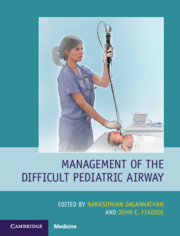16 results
Contributors
-
- Book:
- Management of the Difficult Pediatric Airway
- Published online:
- 10 September 2019
- Print publication:
- 21 November 2019, pp vii-x
-
- Chapter
- Export citation
Appendix - Airway Management Videos
-
- Book:
- Management of the Difficult Pediatric Airway
- Published online:
- 10 September 2019
- Print publication:
- 21 November 2019, pp 229-229
-
- Chapter
- Export citation
Section 1 - Basic Principles, Assessment, and Planning of Airway Management
-
- Book:
- Management of the Difficult Pediatric Airway
- Published online:
- 10 September 2019
- Print publication:
- 21 November 2019, pp 1-26
-
- Chapter
- Export citation
Section 2 - Devices and Techniques to Manage the Abnormal Airway
-
- Book:
- Management of the Difficult Pediatric Airway
- Published online:
- 10 September 2019
- Print publication:
- 21 November 2019, pp 27-160
-
- Chapter
- Export citation
Chapter 12 - Muscle Relaxants
- from Section 2 - Devices and Techniques to Manage the Abnormal Airway
-
-
- Book:
- Management of the Difficult Pediatric Airway
- Published online:
- 10 September 2019
- Print publication:
- 21 November 2019, pp 129-131
-
- Chapter
- Export citation
Index
-
- Book:
- Management of the Difficult Pediatric Airway
- Published online:
- 10 September 2019
- Print publication:
- 21 November 2019, pp 230-236
-
- Chapter
- Export citation
Copyright page
-
- Book:
- Management of the Difficult Pediatric Airway
- Published online:
- 10 September 2019
- Print publication:
- 21 November 2019, pp iv-iv
-
- Chapter
- Export citation
Section 3 - Special Topics
-
- Book:
- Management of the Difficult Pediatric Airway
- Published online:
- 10 September 2019
- Print publication:
- 21 November 2019, pp 161-227
-
- Chapter
- Export citation
Contents
-
- Book:
- Management of the Difficult Pediatric Airway
- Published online:
- 10 September 2019
- Print publication:
- 21 November 2019, pp v-vi
-
- Chapter
- Export citation

Management of the Difficult Pediatric Airway
-
- Published online:
- 10 September 2019
- Print publication:
- 21 November 2019
154 - Otolaryngology
- from Part C - Clinical-based areas in pediatric anesthesiology
-
-
- Book:
- Handbook of Critical Incidents and Essential Topics in Pediatric Anesthesiology
- Published online:
- 05 November 2014
- Print publication:
- 13 October 2014, pp 442-445
-
- Chapter
- Export citation
3 - Airway foreign body
- from Part A - Airway/Pulmonary
-
-
- Book:
- Handbook of Critical Incidents and Essential Topics in Pediatric Anesthesiology
- Published online:
- 05 November 2014
- Print publication:
- 13 October 2014, pp 7-8
-
- Chapter
- Export citation
152 - Otolaryngology
- from Part C - Clinical-based areas in pediatric anesthesiology
-
-
- Book:
- Handbook of Critical Incidents and Essential Topics in Pediatric Anesthesiology
- Published online:
- 05 November 2014
- Print publication:
- 13 October 2014, pp 437-438
-
- Chapter
- Export citation
6 - Difficult ventilation
- from Part A - Airway/Pulmonary
-
-
- Book:
- Handbook of Critical Incidents and Essential Topics in Pediatric Anesthesiology
- Published online:
- 05 November 2014
- Print publication:
- 13 October 2014, pp 14-16
-
- Chapter
- Export citation
153 - Otolaryngology
- from Part C - Clinical-based areas in pediatric anesthesiology
-
-
- Book:
- Handbook of Critical Incidents and Essential Topics in Pediatric Anesthesiology
- Published online:
- 05 November 2014
- Print publication:
- 13 October 2014, pp 439-441
-
- Chapter
- Export citation
14 - Stridor
- from Part A - Airway/Pulmonary
-
-
- Book:
- Handbook of Critical Incidents and Essential Topics in Pediatric Anesthesiology
- Published online:
- 05 November 2014
- Print publication:
- 13 October 2014, pp 33-34
-
- Chapter
- Export citation



